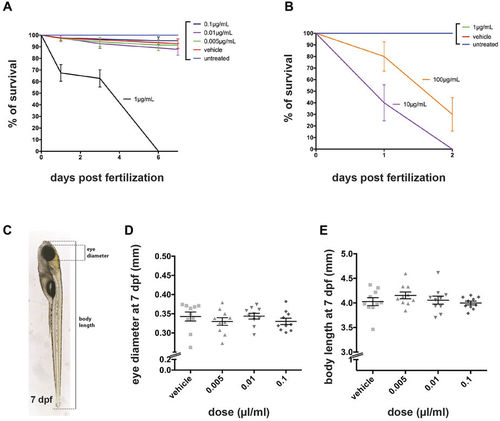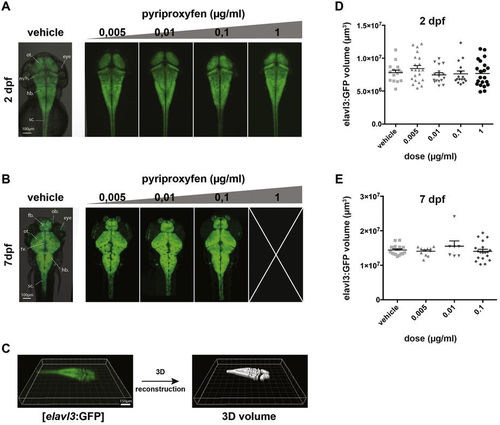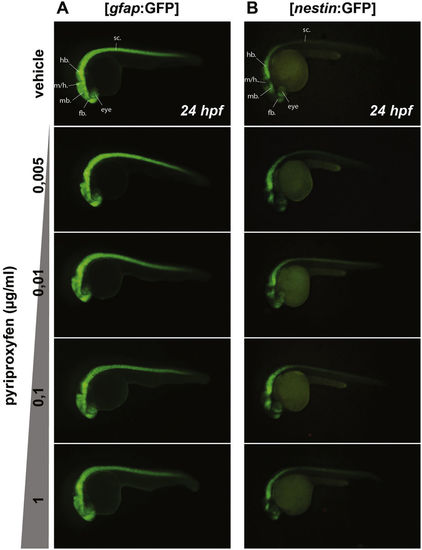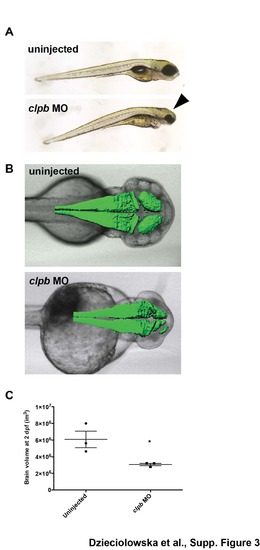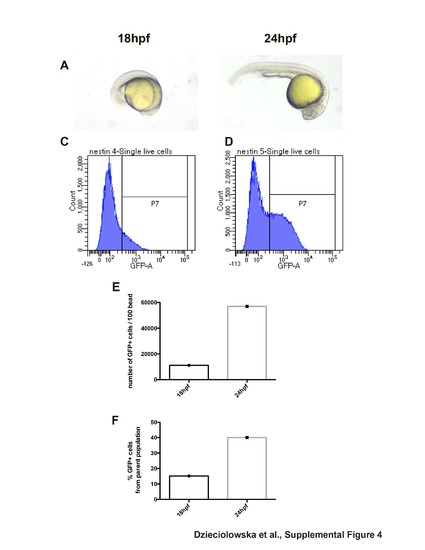- Title
-
The larvicide pyriproxyfen blamed during the Zika virus outbreak does not cause microcephaly in zebrafish embryos
- Authors
- Dzieciolowska, S., Larroque, A.L., Kranjec, E.A., Drapeau, P., Samarut, E.
- Source
- Full text @ Sci. Rep.
|
Pyriproxyfen is toxic at high doses. (A) Percentage of survival of embryos treated from 2–4 cell stage with various pyriproxyfen concentrations ranging from 0,005 μg/ml to 1 μg/ml. The latest dose appears to be lethal with 100% of death after 5 days of development. Lower doses of pyriproxyfen (0,005; 0,01; 0,1 μg/ml) do not induce a severe decrease in the survival rate (N = 2 batches, n = 20 embryos per condition). (B) Higher doses of pyriproxyfen (10 and 100 μg/ml) are lethal as early as 2 dpf (N = 2, n = 20). (C) Representation of measurements performed on 7 dpf larvae to assess gross morphology effects. (D,E) Eye diameter and body length at 7 dpf of pyriproxyfen-treated embryos are not significantly different from vehicle (EtOH)- treated embryos (p > 0.05) (n = 10 per condition). |
|
Embryonic and larval brain volumes are not affected by pyriproxyfen treatment. (A) Transgenic [elavl3:GFP] 2 dpf embryo treated with vehicle, 0,005 μg/ml, 0,01 μg/ml, 0,1 μg/ml and 1 μg/ml pyriproxyfen were imaged under a confocal microscope. The morphology of the embryonic brain is not affected by any of the doses. (B) Transgenic [elavl3:GFP] 7 dpf larvae treated with vehicle, 0,005 μg/ml, 0,01 μg/ml, 0,1 μg/ml pyriproxyfen were imaged under a confocal microscope. Of note is that none of the embryos treated with a dose of 1 μg/ml survived past 6 dpf. The morphology of the larval brain is not affected by any of the doses. (C) 3D-volume reconstruction of [elavl3:GFP] embryos using Imaris software (Bitplane) and confocal microscopy. (D,E) Quantification of embryonic (2 dpf) (D) and larval (7 dpf) (E) brain volumes shows no significant differences between vehicle-treated and pyriproxyfen-treated embryos (p > 0.05). (N = 2, n = 7 per condition). sc.: spinal cord; hb.: hindbrain; m/h: midbrain/hindbrain boundary; mb.: midbrain; fb.: forebrain; ot.: optic tectum; tv.: tectum ventricle; ob.: olfactory bulb. |
|
Neural stem cells regional expression pattern is not affected by pyriproxyfen exposure. 24 hpf transgenic embryos expressing the GFP under the gfap promoter [gfap:GFP] (A) or nestin promoter [nestin:GFP] (B) were treated with different doses of pyriproxyfen from the 2–4 cell stage onwards. Whole GFP expression pattern of both transgenic lines is not affected by the treatment. (N = 2, n = 25 per condition). sc.: spinal cord; hb.: hindbrain; m/h: midbrain/hindbrain boundary; mb.: midbrain; fb.: forebrain. |
|
clpb-morpholino induced microcephaly leads to a reduced brain volume in zebrafish embryo. (A) 48 hpf embryos injected with a clpb morpholino exhibit a microcephaly phenotype (e.g reduced head size, black arrow head) as described by Capo-Chichi et al.39 (B) elavl3:GFP embryos were injected with clpb morpholino and imaged at 48 hpf under a confocal microscope. (C) The 3D-brain volume calculation shows a reduced brain volume compared to uninjected embryos. |
|
nestin+ population quantification from 18 hpf versus 24 hpf embryos. (A) Bright field image of 18 and 24 hpf embryo. (B, C) The GFP+ cell population (e.g.[nestin:GFP]) was distinguishable using a 488 nm laser with a 530/30 BP filter (population labeled P7). The fluorescent beads were distinguishable using a 561 nm laser with a 610/20 BP filter and a 405 nm laser with a 525/50 BP filter. (E) The number of nestin+ cells counted per 100 beads increases by a factor of 3 in 24 hpf embryos compared to 18 hpf embryos (F) The same results presented as a percentage of GFP+ cells/parent population also show an increase in the number of GFP+ cells at 24 hpf. (N=1, n=25 embryos) |

